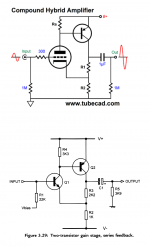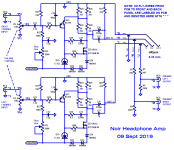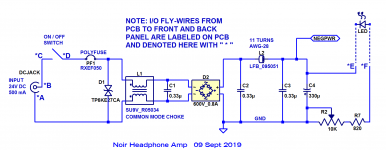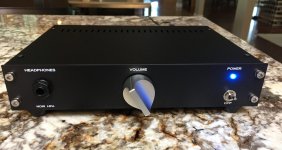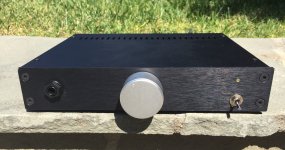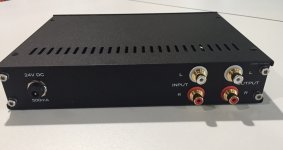This thread is for discussions about the Noir headphone amp, whose
PCB is available in the diyAudio Store. Its features include:
- Solid state, all discrete: no ICs, no vacuum tubes
- Single ended, Class A circuit operating at 150 mA bias current (exceptionally high for a headphone amp)
- No mains voltage inside the DIY chassis. Power is supplied by a commercial, safety rated, wall wart @ 24V DC
- All thru-hole parts, mounted on a single PCB with generous spacing between components
- Very easy to stuff and solder; suitable for first time DIYers. Component IDs and component values printed on PCB silkscreen.
- Headphone output on front panel, linestage preamp output (RCA jacks) on rear panel
- Pre-made front and rear panels, drilled and silkscreened, for DIYers who prefer not to do metalwork themselves. These are black PCBs, 2.0mm thick, cut to match the diyAudio Store "1U Galaxy" chassis front & rear panels.
- Detailed, 37 page .pdf file named "Noir Build Instructions" walks you through the assembly process with plenty of photos. It's 4.7 megabytes long, over the size limit for attachments here on the Forum, but is available for download on the sales page of the Store.
AMPLIFIER CIRCUIT
The Noir amplifier is a two transistor circuit, which is an idea that has been around quite a long time. Figure 1 top shows a hybrid tube+transistor amp circuit, and Figure 1 bottom shows an all-BJT version (from D.Self's book), to name but two examples. Noir takes this basic circuit and simply scales up the second stage bias current to 150 mA, then employs high wattage power resistors as the "collector loads." Simple.
Fig 2 is the Noir schematic. Compared to Figure 1, the device polarities have been reversed. Now the input transistor is P-type and the output transistor is N. This is advantageous because N-channel MOSFETs have a gain-per-unit-silicon-area which is proportional to
electron surface mobility. P-channels' gain is proportional to
hole surface mobility, and is 2-3X less. All we need to do is flip the power supply upside down, and we get 2-3X higher gain per unit capacitance. An easy decision. Thus Noir uses a positive-ground, negative-supply arrangement, with the supply rail "NEGPWR" at about -22 volts. Just like germanium transistor radios in the late 1950s.
Transistor Q71 and "current regulating diode" D75 (a constant current source) form the input stage of the amp. They drive the gate of output transistor Q72, whose drain load is a 12 watt, 68 ohm resistor, implemented via a series-parallel arrangement of four 3W, 68R resistors. Each of these resistors dissipates less than 0.5 watts during operation, and even though they have a comfortable margin of safety (6X), they do get quite warm during operation. The midpoint tap of the resistors provides feedback from output stage to input stage. Thanks to equal resistor values on the top and bottom of the voltage divider, feedback is (1/2), thus gain is 2X (+6 dB). This choice of gain encourages the user to set the volume control potentiometer somewhere in the second half of its rotary travel, where channel-to-channel tracking is best.
Noir has a single ended power supply so it needs AC coupling at input and output; C72 and C76+77 provide these. As with other capacitor-coupled amps (notably the Pass ACA), Noir does produce an audible "thump" at turn on and turn off. If you find the thump objectionable, some elimination strategies include leaving the unit on at all times (as Pass suggests for the ACA), unplugging the headphones (or removing them) first, installing additional circuit boards/modifications inside the Noir chassis, et cetera.
POWER SUPPLY
Fig 3 is the supply schematic. The DC wall wart output is filtered by a common mode choke and applied to a bridge rectifier. This means Noir can accept both (positive center, negative sleeve) wall warts and also (negative center, positive sleeve) wall warts. An LC output filter is then applied for additional smoothing. Potentiometer R2 and resistor R7 let builders adjust the current flowing through the LED "pilot light" and thus, its brightness.
CHASSIS OPTIONS
Fig 4 shows Noir in a "1U Galaxy" chassis from the diyAudio Store, with the silkscreened PCB front panel installed. Fig 5 shows the same unit, but this time using the brushed aluminum front panel that ships with the chassis. (I drilled it myself, using a drill press). I don't own the necessary tools to engrave lettering on the panel, but perhaps that's not necessary. There are only three objects and the function of each one is so obvious that perhaps no lettering is needed. Headphone Jack, Volume Control, Power Switch. Simple.
Fig 6 shows the rear of the unit using the PCB back panel. Here it definitely IS helpful to have lettering, to help you remember which RCA jacks are inputs and which are outputs.
Fig 7 shows the stuffed and soldered PCB for Noir.
The final attachment is a Bill Of Materials
in Excel Spreadsheet format for Mouser's BOM tool. The
Noir sales page in the diyAudio Store has a link to a populated Mouser
shopping cart, which might be more convenient when you're ready to order parts.
DIY BUILD COST
Now that the Store prices have been announced, we can estimate the cost of building a Noir at home: $70 for PCB + chassis, $85 for Mouser BOM (drops to $80 if you buy the ALPS Blue Velvet potentiometer at
parts-express dot com instead of Mouser), $5 to $10 for fancy solid aluminum volume knob from eBay, $5 for misc nuts and bolts at your local hardware store. Total cost: approx $165. Of course you are free to purchase "Premium Parts" (exotic film capacitors, $100 potentiometers, silver wire, etc) if that's your pleasure.
HOW DOES NOIR SOUND?
Played into my Sennheiser HD 650s and also my A-T M50Xs, I would say that Noir is
nuanced. Female vocals (Joan Diener, Marianne Faithfull, etc) were ethereal and otherworldly. And yet full orchestras sounded detailed and crisp, forceful with no detectable muddiness. "Mars" from Holst's "The Planets" suite was suitably terrifying. And ZZ Top kicked assz like only ZZ Top can do. Put on "Tres Hombres" , toss back a couple shots of Anejo , and daydream of Terlingua and Saragossa.
OLD DISCUSSION THREAD
Early prototypes of Noir were called by the code-name "T2". There was a forum thread for discussing T2,
here, now closed, whose coverage of the early days might be of historical interest.
_
